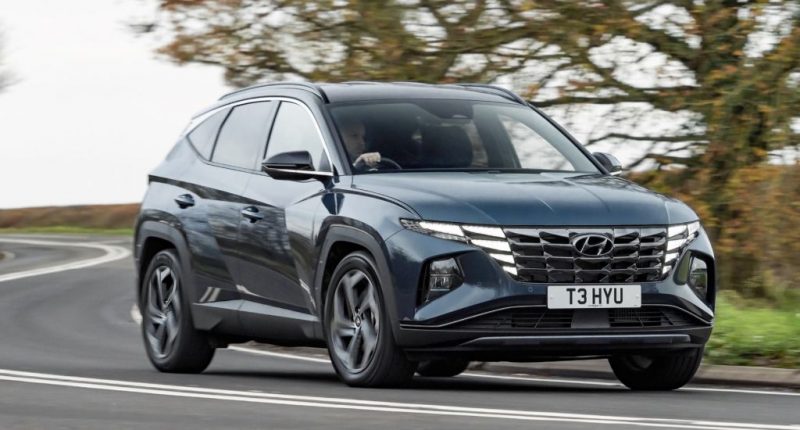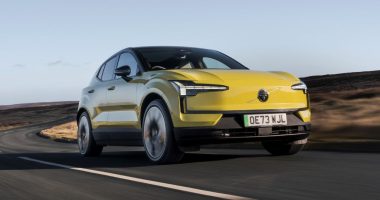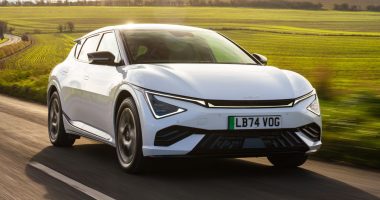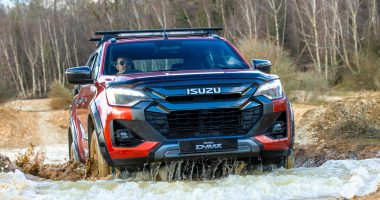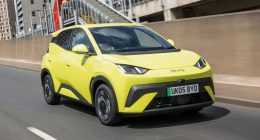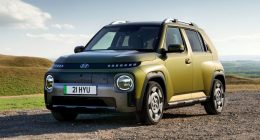How many times have you read that SUVs are all the rage right now? There’s every chance one takes pride of place in your driveway, or indeed your neighbour’s (or your neighbour’s neighbour’s). On your daily commute you’ll lose count of how many you come across, then. So how to stand out from the crowd? Hyundai thinks it has the answer.
Table of Contents
IT’S BUSY IN THE LOOKS DEPARTMENT
Hyundai says the fourth-generation Tucson ushers in a “design revolution” and few can argue that the overall look is both distinctive and pretty radical. This is one of the ways the company believes it can get even more bums in the seats of this big-selling SUV which has driven off forecourts 1.4 million times in Europe and a further 5.6 million times around the rest of the world over the last 16 years. If you like SUVs, and you like being noticed, then this Tucson has both those bases covered. For starters, the front grille integrates a ‘fang’ arrangement of multi-pennant LED running lights that are completely hidden when the car is not being driven; chiselled flanks that appear to take a leaf out of the current Toyota RAV4’s book; shark fin shapes on the D-pillar’s brightwork and tail-lights; and a full-width LED lightbar that not only sounds ace but looks it as well. Wheel sizes vary between 17-, 18- and 19-inches, and there are up to ten colour options including our test car’s ‘Amazon Grey’ metallic hue (£665).
THE STYLE COMES AT A PRICE
SUVs are common as muck right now and so too is the phrase “further upmarket” – two words that mainstream car companies, like Hyundai, fall back on to justify price hikes. In the Tucson’s case, entry-level ‘SE Connect’ is £5,000 more than the equivalent trim on the Mk3 Tucson. That being said, better equipment levels help soften the blow, but there is no getting away from the fact higher-spec ‘Premium’ and ‘Ultimate’ cars are nudging dangerously close to prestige marques such as Volvo – who sells the suave and sophisticated XC40 – and Audi, which has the solid and dependable Q3 within its burgeoning ranks. Sporty ‘N Line’ and ‘N Line S’ push the current Tucson model count to five making sure there is something for everyone – a sentiment that equally applies when it comes to choosing your engine.
PETROL OR PETROL ELECTRIC?
The 1.6-litre, four-cylinder turbo petrol is the beating heart of the Tucson and it comes in four unique flavours. In its most basic form it produces 148bhp but with 48-volt mild hybrid assistance this raises power and saves fuel in stop/start scenarios while briefly upping torque under acceleration. Our test car was one rung down from the full plug-in hybrid and so gets a 1.49kWh battery to power a 44.2kW e-motor that sits between the engine and transmission to help with the heavy lifting when moving off, at town speeds or at a steady cruise for brief periods. There is much to admire about the set-up, chiefly how it switches between one power supply to the other without you ever noticing. ‘Sport’ mode adds an edge to throttle sensitivity and engine response, and tightens the dampers if the optional Tech Pack (£1,250) is requested as this adds the brand’s ‘Electronic Control Suspension’. Hyundai claims it reduces roll and pitch for improved control and cornering and having tested that theory we would tend to agree, yet giving up that compliancy is felt over harsh surfaces. If it were us, we would leave the ESC button alone.
WHAT’S IT LIKE INSIDE?
There are more than subtle hints of premium brands at play in the cabin as far as presentation goes anyway. It can’t meet the Germans in a game of quality Top Trumps but the Tucson is by no means disgraced as shown by the silver highlights and gloss black plastics. Aesthetically, the sweeping trim lines, entirely touch-operated centre console and toggleable 10.25-inch driver display that appears just ahead of the heated steering wheel are among the key talking points inside. As for standard kit, heated and cooled leather seats, ambient interior lighting, a full-length panoramic sunroof, wireless charging pad and a KRELL-developed stereo are all here. We do have one major gripe, however, and it concerns the multimedia display; a quick count confirms it has no fewer than 24 buttons to adjust fan speed, temperature, speaker volume and access the sat-nav. In short, it’s too many and what starts out as a clean and shiny surface soon ends up masked with grubby finger prints and smudges. Some physical buttons wouldn’t go a miss.
IS THE TUCSON PRACTICAL?
From folding – and reclining – back seats to a 577-litre boot in MHEV versions that mushrooms to a not-too-shabby 1,756-litres when the 60/40 split-folding rear chairs are pushed down out of the way, the Tucson makes a strong case for itself as a family-friendly SUV. In the load area you’ll also find a height adjustable floor, 12-volt socket to power a handheld vacuum or charge a head light or hand-held torch, and anchor points to tie valuable cargo to. Three average-sized adults can expect to travel in the second row without finding themselves fighting it out for leg, head or shoulder room, and when the middle seat isn’t occupied the outer two occupants can lower the centre armrest for added comfort and convenience. And then there are touches like the the switches on the shoulder of electric-powered front passenger seats that make it easy for the driver or rear occupants to slide it forward when parked up or on the move.
PROS & CONS
+ All round premium feel
+ Cavernous interior; big boot
+ Electrification helps economy
– Centre console too complicated
– Styling similar to marmite
– Occasional choppy ride
REMOTE SMART PARK ASSIST: Part of the £1,250 ‘Tech Pack’, and only available on hybrids, this clever piece of tech will park, or retrieve, the car for you. Via the key fob, you can move the car forwards and backwards at low speeds from four metres away, with all-around sensors preventing you from crashing it. This is a useful feature, especially in tight multi-storey spaces where access is generally restricted.
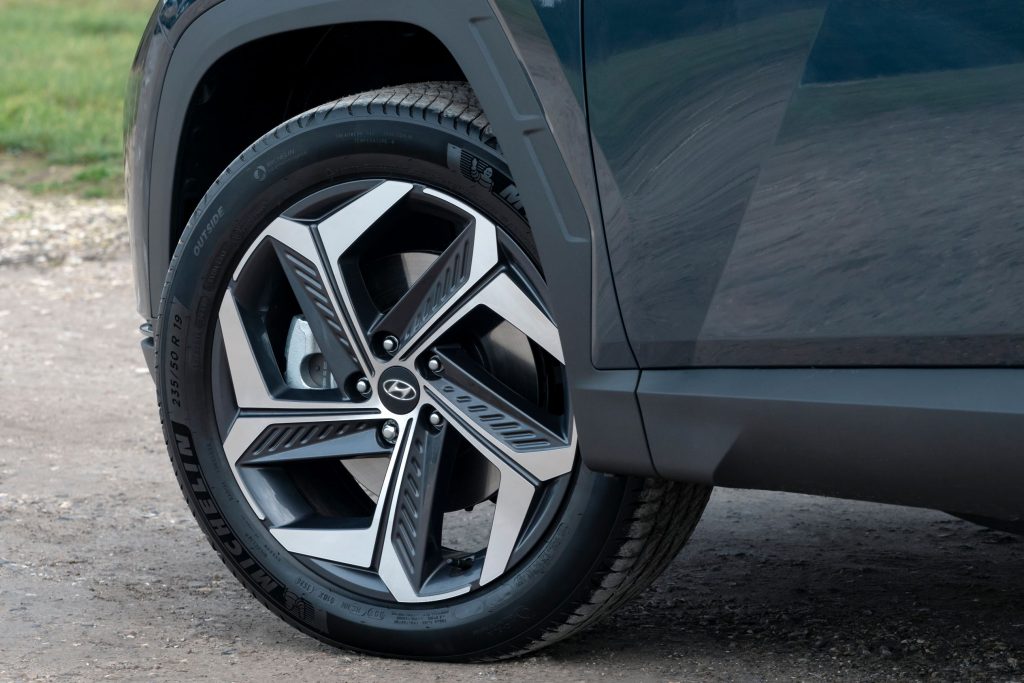
STYLING: The Tucson makes quite the statement when seen in the metal for the very first time thanks to sharp angles and bold creases that conceal the fact the Mk4 is 20mm longer and 15mm wider than the car it replaces. Customers have up to ten exterior paint colours to choose from and every one can be combined with a contrasting roof. Our top-spec ‘Ultimate’ model sat on 19-inch bi-tone alloy wheels.

INTERIOR: The button count inside the Tucson is low because the majority of commands are executed via the slabby central display which isn’t the simplest to fathom when driving. The 10.25-inch driver binnacle is a better success and incorporates the optional Blind Spot View Monitor as found in the cars of sister brand Kia. A full-length sunroof and leather upholstery are standard on ‘Ultimate’ examples.

PRACTICALITY: Occupants will be happy to travel in the Tucson because its has generous proportions. Window blinds, row two climate control, cup holders and USB points also see them right. The transmission tunnel hump in the floor does rob the middle occupant of foot space but, overall, the rear scores highly. Wagging a foot underneath the rear bumper raises the electrically-powered tailgate to reveal a 577-litre load area.
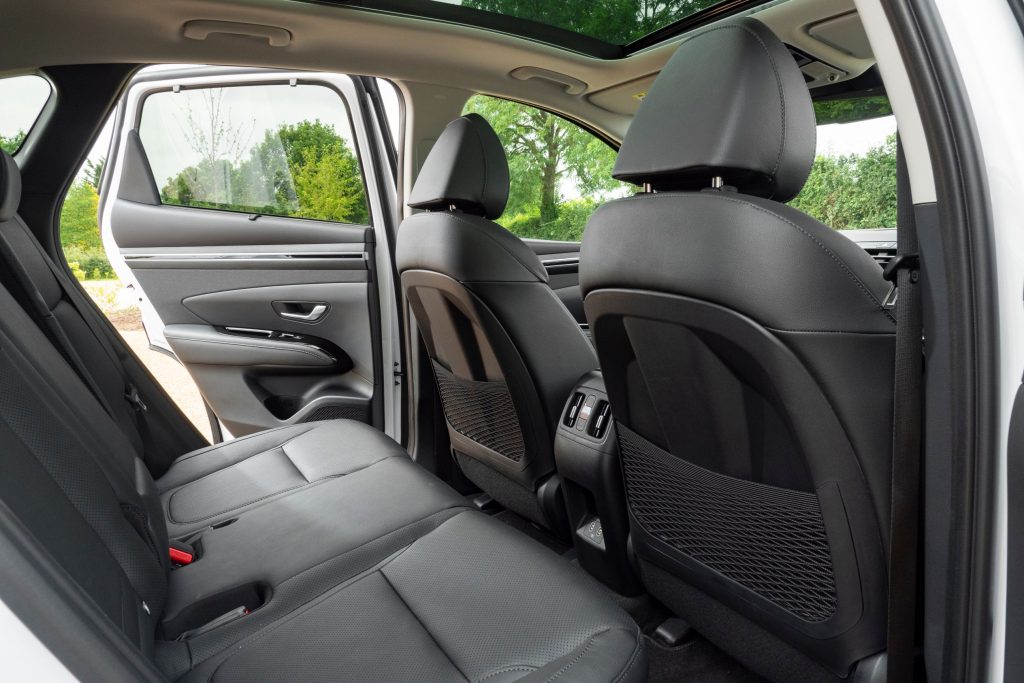
SPECIFICATION
Price: £39,365 (as tested)
Engine: 1.6-litre, 4cyl petrol with e-motor
Power/torque: 227bhp/195lb ft
Transmission: 6-speed automatic, front-wheel drive
0-62mph: 8 seconds
Top speed: 120mph
Economy/CO2: 49.6mpg/131g/Km
